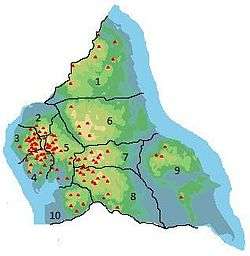Pen-y-ghent
| Pen-y-ghent | |
|---|---|
 From the path from Horton | |
| Highest point | |
| Elevation | 694 m (2,277 ft) |
| Prominence | c. 306 m. (1,004 ft) |
| Parent peak | Whernside |
| Listing | Marilyn, Hewitt, Nuttall |
| Coordinates | 54°09′19″N 2°14′59″W / 54.15528°N 2.24972°WCoordinates: 54°09′19″N 2°14′59″W / 54.15528°N 2.24972°W |
| Naming | |
| Translation | Hill on the border (Cumbric) |
| Pronunciation | /ˈpɛnᵻɡɛnt/ |
| Geography | |
 Pen-y-ghent Yorkshire Dales National Park | |
| Location | Yorkshire Dales, England |
| OS grid | SD838733 |
| Topo map | OS Landranger 98 |
Pen-y-ghent or Penyghent is a fell in the Yorkshire Dales. It is one of the Yorkshire Three Peaks, the other two being Ingleborough and Whernside. It lies 3 kilometres (1.9 mi) east of Horton in Ribblesdale. The Pennine Way links the summit to the village; the route is around 5 kilometres (3.1 mi) in length as the Way curves initially to the north before turning east to reach the summit.
The more direct route that traverses the southern 'nose' of the hill is the route usually taken by those attempting the Yorkshire Three Peaks Challenge, as the walk is usually (but not exclusively) done in an anti-clockwise direction starting and finishing in Horton in Ribblesdale. The other main hillwalking route on the hill heads north from the summit to reach Plover Hill before descending to join the bridleway that is Foxup Road.
In the Cumbric language, exactly as in today's Welsh, Pen meant 'top' or 'head', and y is most likely the definite article (the), exactly as in Modern Welsh y. These elements are common in placenames throughout the island, and especially in Wales (compare Penyberth 'end of the hedge/copse', or Penyffordd 'head of the road/way', etc.). The element ghent is more obscure, however: it could be taken to be 'edge' or 'border'.[1] The name Pen-y-ghent could therefore mean 'Hill on the border' (compare Kent).[2] Alternatively, ghent could mean 'wind' or 'winds' – from the closest Welsh transliteration, gwynt ('wind'). Thus it might mean simply 'Head of the Winds'. It is also possible that ghent may have been a tribal name and that the hill may have once been an important tribal centre. It is also acceptable to write the name as Pen y Ghent rather than Pen-y-ghent.
.jpg)
References
Bibliography
- Bibby, Andrew (2008), The Backbone of England, London: Francis Lincoln Limited
- Ekwall, Eilert (1960), The Concise Oxford Dictionary of English Place-Names, 4th ed., Oxford: Oxford University Press
External links
- Computer generated summit panoramas Pen-y-ghent index
- Photos of Pen-y-ghent and surrounding area on geograph.org.uk
- Climb Pen-y-ghent from Horton-in-Ribblesdale
